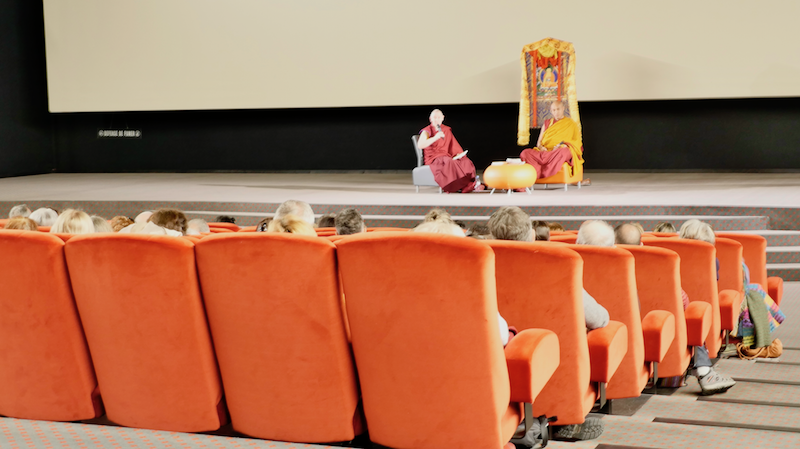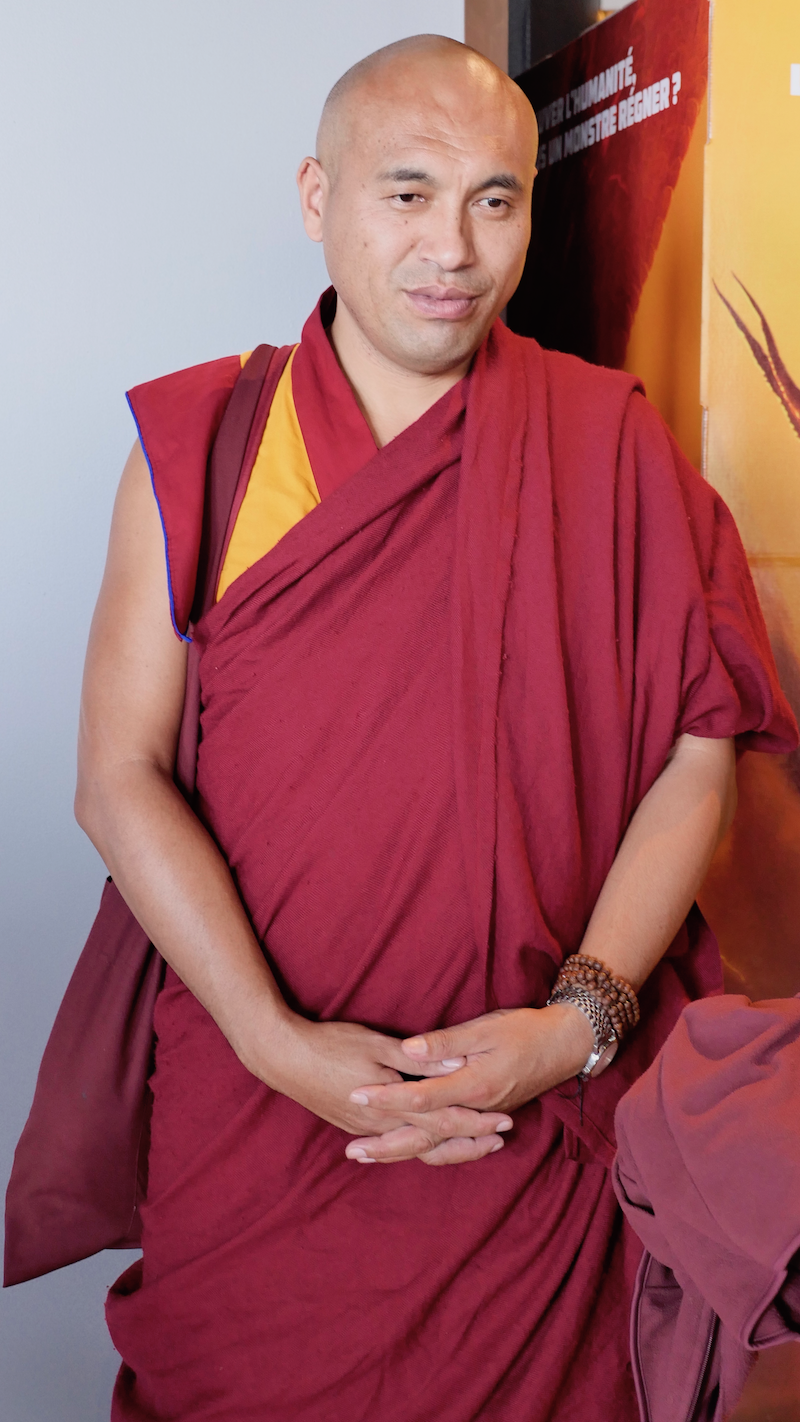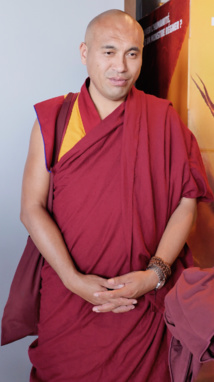
Mahayana means reaching out to the largest possible group of sentient human beings to bring about enlightment and freedom from suffering on the third level of the stages of the path towards enlightment. The Gelugpa tradition is that followed by His Holiness the 14th Dalai Lama, otherwise known as Tenzin Gyatso.
Guesche Losang Tenzin is presently based at Dagpo Dratsang monastery in Kaïs, Northern India. Born in 1978 in Lhoka, Southern Tibet, he fled to Nepal in 1997 on a long and tortuous journey before reaching India where the monk hoped to intensify knowledge of Buddhist philosophy.
Losang Tenzin was received by HH 14th Dalai Lama in Dharamsala with others who had escaped through Nepal. He chose to join the college of Drepung Gomang in Southern India between 1999 and 2007, to pursue his studies. The monk obtained his doctorate in Tibetan Buddhist philosophy as a Guesche Katchoupa (the guesche title is conferred on those who achieve the doctorate). Despite suffering extremely bad health during his studies, Guesche Losang Tenzin recovered sufficiently and currently teaches Buddhist philosophy to forty young monks at Dagpo Dratsang monastery every year.
At the Saint Nazaire cinema complex, the first part of the conference took place on Saturday afternoon
Guesche Losang Tenzin greeted the public with the Tibetan expression 'Tashi Delek' to thank them for coming. Facing the public the tall monk sat with crossed legs in lotus position on an orange chair in front of a scrolled depiction of Buddha Shakyamuni with the interpreter on his right.
The monk reminded the public that all living beings, including animals, aspire to escape suffering and gain happiness. The difference is that sentient human beings possess greater capacity to achieve these aspirations because they are fully endowed with favorable mental faculties and physical bodies, although these remain impermanent in nature.
Of crucial importance are the methods available to liberate oneself, and other sentient beings, from physical and mental sufferings. The Buddhist approach offers excellent possibilities because the teachings aim to help all sentient beings on their way to gradually achieving such goals.
Firstly common sense shows that yoga of the physical body which includes excellent nourishment, sport and care of bodily needs, contributes towards general well-being.
The second aspect is that of ensuring mental calm by employing proven methods used by Tibetan Buddhists of the Mahayana School of the Gelugpa tradition. These methods calm the mind of mental anguish and contribute towards gaining mental calm, also known as Shamata in Sanskrit.
The path leading towards meditation which ensures mental calm is that of concentration. Freeing oneself from attachment to worldly affairs and ignorance of the causes of suffering, has repercussions all around us in society, we will all feel more serene if we meditate regularily.
Those who practice meditation on a daily basis will soon notice its benefits. Each individual has to decide on which object of meditation to focus. We have to analyze what the object of our meditation should be and discern where our own problems lie. Gradually we will progress on our journey by concentrating on virtuous objects and ignoring worldy distractions.
Preparation of the place of meditation is very important - we should ensure that it is clean and situated as far as possible from disturbing noises. We begin by focusing on how to live more frugally. Ideally this implies limiting our worldly activities and practicing an ethical way of life, avoiding the ten non-virtues, seven on the physical and oral level, and three on the mental level. Silence while meditating is primordial.
Buddhists generally chose to meditate with the representation of Buddha Shakayamuni, but it is always possible to meditate with other sources of light. Recommended is choosing a certain time of the day to meditate : it is good to start the day by calming our spirits and concentrating on our breathing.
To prepare the way, we have to avoid being tempted by forms, sounds, taste, smells and tactile sensations which are governed by mental consciousness of our minds
Several sessions of five minutes without forcing ourselves is recommended, otherwise we may lose momentum and our attention about the object of meditation will waver and be dissipated. We may get irritated at others without realizing that we ourselves irritate them by our own behavior. We ignore that there are 12 interdependent links that bind all human beings from which we should strive to free ourselves.
This brings us to the realization of what causes bring us the effects we are striving to achieve - causes and effects are always present. Gradually we become aware of what produces happiness and calmness. To counter irritation for example we should meditate on love for others.
The next morning, further clarification by Guesche Losang Tenzin
First, we have to fix our minds on the object of meditation and begin to understand matters as they are without being distracted. This leads to stability of the mind. Perseverance follows and progress will come slowly after repeatedly concentrating which should encourage us. Fixation of the mind continues, followed by repeated fixation which enables a larger capacity of our memory to concentrate, our faculties improve. Wandering of the mind can be overcome despite a certain lethargy. Now is the moment to inject a new impulse of energy and apply remedies for lack of concentration, while remembering the benefits of meditation brought about by faith for instance.
Partial pacification of these obstacles follows by discarding attachment of the mind to certain objects, such as laxity in concentration. Complete pacification of the mind can only follow by being more vigorous and manifestly concentrating on the chosen point. Complete pacification of the mind is present when excellent concentration comes spontaneously.
At this stage, one realizes that mind has become pliant and concentrated with acute perception. One's mind obeys the instructions given and the capacity to to evaluate the objects of meditation is almost complete.
To recapitulate the following points are recommended :
1. Studying with the help of a proven master
2. Reflection on what he has taught and personal experience
3. Memorizing the stages of the path of concentration
4. Remainging vigilant and confronting the obstacles to concentration
5. Employing enthusiastic effort
6. Continuing to proceed to concentrate to overcome obstacles
7. Pacification of obstacles like laziness, discouragement, boredom, or distraction
8. This leads to almost complete concentration on the objects of meditation
9. Then spontaneous concentration will follow, the mind becomes supple, perceptions very acute and watchfulness grows while memorizing the path to wisedom.
Studying with an excellent master improves this state of mind, which leads to reflection and memorization of important points. Vigilance of the mind while undertaking meditation increases and our mind becomes accustomed to such excellent habits.
It is important to remember the remedies to prevent laziness of the mind, the conviction that faith and belief help the mind retain its suppleness and leads to wisdom. Continued effort will lead to constant attention and slowly lead to equanimity, while retaining clarity and interior calm.
These results take time of course and constant, consistent daily practice, but slowly our minds will improve, and bring about beneficial conditions of life, especially for those who practice a profession involving helping others such as doctors or nurses who may suffer from great stress.
Even if you do not follow a Buddhist master, you will notice the benefits of concentration and compassion for others. Our main aim in life is not only to help ourselves, but also to help other sentient beings on their way to well-being, and eventually, to full enlightenment. We must never forget that generosity, patience and ethics are extremely important.
to introduce methods to discover, study, reflect and meditate on Buddha's teachings.
Moral and spiritual guidance is provided by Venerable Tibetan Lama Dagpo Rimpoche based in Veneux-les-Sablons, France.
Monthly : workshop about meditation in Saint-Nazaire.
- Free
- Contact : nantesgroupedetude@yahoo.fr
- Organised by Institut Kadam Tcheuling Nantes (IKTN)
















